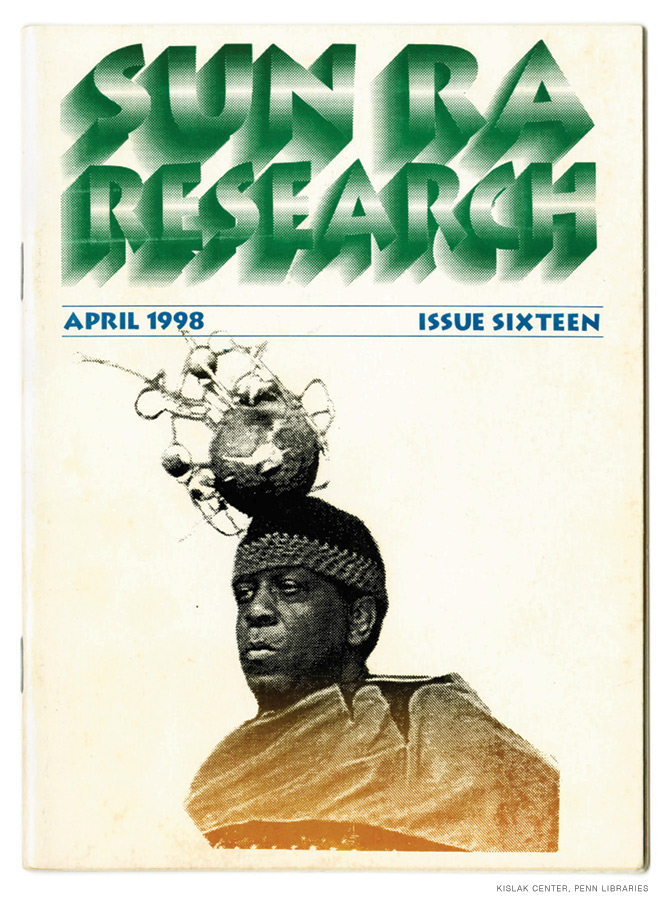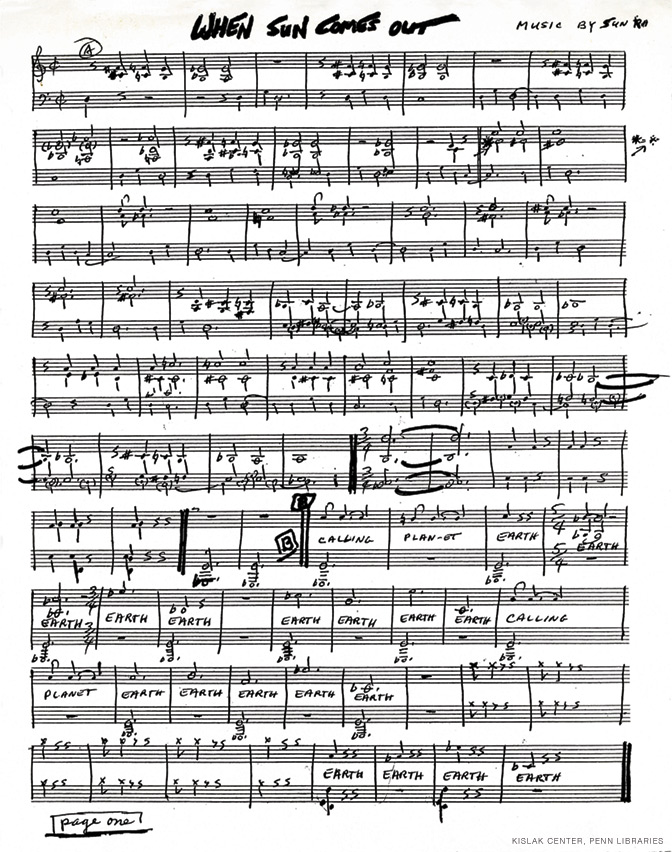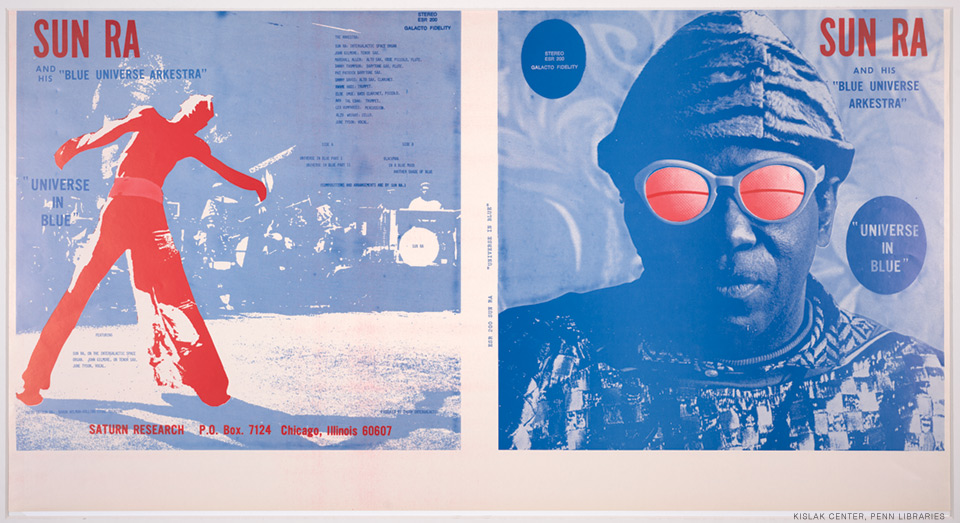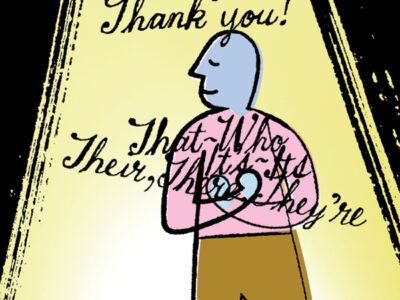
Penn Libraries acquires two collections illuminating the inimitable Sun Ra.
Penn never invited Sun Ra to perform on campus, and jazz historian John Szwed takes the blame. Szwed directed the University’s Center for Urban Ethnography and chaired the Department of Folklore and Folklife during the 1970s—when the otherworldly jazz composer ran his legendarily idiosyncratic Arkestra out of a rowhouse in the Germantown neighborhood of Philadelphia. Cloaked in iridescent capes and robes, the musicians were known for veering from big-band swing to avant-garde electronic experimentation in mesmerizing performances where saxophone colossuses vied for attention with body builders, fire-eaters, shadow puppets, and contortionists.
Their leader Sun Ra, a pianist whose Afrofuturist mysticism rivaled his instrumental arrangements in terms of shapeshifting originality, became a Philadelphia fixture. He read poetry on WXPN during the station’s student-run heyday and played plenty of college concerts. “Sun Ra had gigs at Haverford, Princeton, Temple, Swarthmore,” Szwed noted during an October virtual public talk hosted by the Kislak Center for Special Collections, Rare Books, and Manuscripts. “But not Penn,” he continued, “and I’ll make myself guilty of this, because I was here and didn’t invite them.”


But 30 years after Sun Ra’s 1993 departure from the earthly plane, Szwed carried out what might be called an act of academic penance: the author of the 1998 biography Space Is the Place: The Lives and Times of Sun Ra gave his research archive from that project to Penn Libraries. It ranges from sheet music and audio cassettes of radio programs (including those from WXPN); to a run of 50 issues of the Sun Ra Quarterly and Sun Ra Research magazine containing poetry and band interviews; to a collection of letters from people who were close to the Birmingham, Alabama, native, who abandoned his christened name Herman Poole Blount in favor of a handle honoring the Ancient Egyptian sun god.
During the Kislak Center talk, Szwed reminisced about encountering records for sale at an Arkestra concert in Swarthmore in the late 1960s. Puzzled by their packaging—“they all had white covers with no names”—he asked an Arkestra member for an explanation. “And he said, ‘Well, this one is outer space music. And this one is cocktail music.’” Szwed bought one of each, took them home, and was baffled to find them exactly as advertised.
“One was using synthesizers and radical electronic devices,” he recalled, “and the other was ‘Tea for Two’ and tinkling pianos. And I thought, What is this? What’s going on here? So Sun Ra was a mystery.”
Szwed, who joined the Yale faculty in 1982, spent the rest of the century, on and off, trying to solve it. “The surprise,” he said, “was to find out that he was a serious reader and serious scholar—and was keeping books of concordances of translations, multiple translations of the Bible, all kinds of things—but also spiritual works on other cultures.”
Reflecting on the composer and bandleader’s insistent focus on philosophical matters and cultural criticism, Szwed characterized Sun Ra as a bearer of messages “disguised as jazz.”
“He put out a series of books that all had the same title, and usually the same picture,” the biographer said, “but the material inside was never the same. And the only way you could possibly know is just to collect the books and read them.”
The Penn Libraries tentatively plans to mount a public exhibit on Sun Ra and Afrofuturism in August 2026. It will draw from Szwed’s archive as well as a second recent acquisition, from Boo-Hooray gallery in New York, that focuses on original album art, photography, posters, and other visually compelling artifacts tracing the history and influence of the Arkestra (which continues to play to this day, under the direction of the 99-year-old alto saxophonist Marshall Allen).
“There’s a kind of artist who is on the fringes, who’s so far out that they’re not well known, and they will never be well known,” Szwed said about Sun Ra (and others like him). “But they affect other people. They’re known among the known, and not to the rest of the people. So these eccentrics are rather important people.”
Important enough, it turns out, that somebody thought to lure him to campus—or its underground fringe, at any rate—back in the day. Specifically, to Geno’s Empty Foxhole, in the basement of the parish hall of St. Mary’s Church in Hamilton Village.
“He did appear there a number of times,” said Szwed, singling out a performance where the bandleader used industrial-strength fans to fill the room with a mighty wind.
“Everyone [in the audience] was being blown back,” Szwed recounted, “and then Sun Ra turned around and his cape went over his face. So he rips the cape open so his face would come through—and somebody, stoned in the back, said: ‘My God! He ripped a hole in space!’” —TP





John Szwed is America’s great biographer of vernacular and folkloric culture bearers. In addition to Sun Ra, his recent work on avant garde folklorist Harry Smith,, “Cosmic Scholar” follows an amazing list of books about Miles Davis, Billie Holiday and Alan Lomax among others.
His aesthetic attention to cultural “crossovers,” including his own, and creolization are beyond compare. As a student of his in the 1970s, I found a track of documenting and presenting vernacular performance art and artists on radio and elsewhere that carried me from researching deep tradition of Afro Creole zydeco musicians in Louisiana to bringing Mardi Gras Indians and New Orleans traditional jazz to Carnegie Hall, the National Mall and to concertizing in China.
Thank you John for all you’ve done.
Nick Spitzer
American Routes
Tulane University